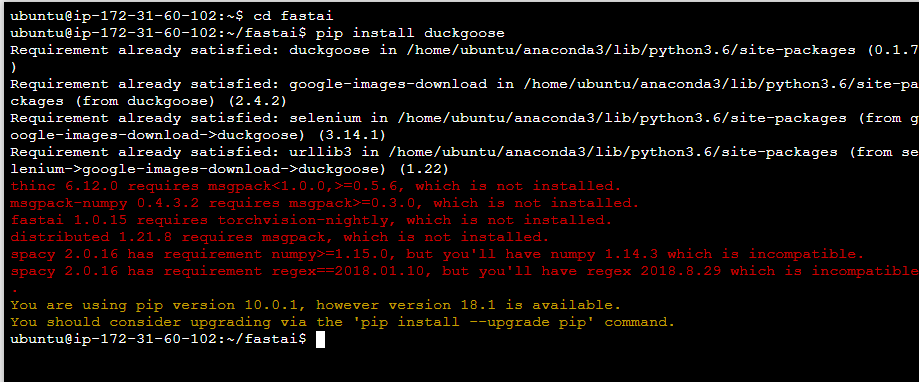Thanks for the clarification. I could have missed those details earlier 
@ashtonsix
How can we upload data from local device to Salamander?
@Bibek setup your access key on Salamander & find an application suitable for your OS. I personally use the “Connect to server” functionality inside Nautilus (Ubuntu). For Windows WinSCP might work. You’ll probably find a better solution by searching on the internet than asking me (I’m not the best person to ask for general computer help).
@ashtonsix @Bibek easier is to simply click “Upload” on the main jupyter notebook page.
How do I install chromedriver on Salamander? I’m trying to use duckgoose (https://github.com/svenski/duckgoose) to get Google images.
I can’t seem to create a python3 or any other notebook other than fastai… if I try to change kernel, it switches back to fastai.
I’ve been trying for an hour or two, at random times - I can’t get the web form up - always say someone else is using it…
chromedriver: connect to your server and follow the installation steps they provide for Ubuntu.
python3 kernel: if you want to use the python3 kernel create notebooks outside the fastai directories
adding credits: if you see a loading spinner do not refresh the page (you’ll lock yourself out). working on some tweaks to improve how the browser is managed
@ricknta It looks like AWS, after seeing all the failed / abandoned sign in attempts has temporarily locked my account & although everything is still running I’m unable to access the console. Might have to rethink how credits are added.
@ashtonsix can you take a look at this thread:
I’m unable to get fastai updated to the latest version. Help! ![]()
Ps: I realize you’re probably asleep right now…
How do we install a package properly? I used pip install with duckgoose and google_images_download, both seemed to install ok, but I can’t access them from a nb.
Ah, now I’ve looked again - I previously ran pip install from the root folder…when I run it from the fastai folder I get errors:
I freely admit I don’t know what I’m doing!! 
@ricknta Make sure the fastai virtualenv is active before you install new packages, otherwise you won’t be able to import them inside the fastai kernel (run source activate fastai before pip install [package] or conda install [package]).
fyi conda update fastai can fail because of incompatibilities with other packages, but conda doesn’t report any problems by default. To see why conda update fastai won’t install the latest version of fastai activate the fastai virtualenv & try running conda install -c fastai fastai==1.0.15 (specify the exact version). As this isn’t specific to Salamander this thread is probably the best place to report anything you discover & get further help with upgrading fastai.
@ashtonsix Thanks. I first tried what @lesscomfortable suggested on git, which is what I see you now have in the Returning to Salamander page:
source activate fastai
conda install -c fastai fastai
and then restarted the machine. That worked!
I think it would help if you add at the end of the Returning to Salamander page that you have to restart. It does say to stop your server, but I had tried that (meaning restarting) several times after trying different update approaches and it hadn’t made a difference so I wasn’t sure it was important. Hope this helps.
Also thanks for the new package install info - I didn’t know I had to run source activate fastai before pip install. That works.
I’m glad everything’s working for you again
Have you tried closing and re-opening your notebooks after installing? That should work and it is easier than restarting.
Good to know. I had tried that initially but probably didn’t realize it would work since my basic install wasn’t working at that point.
Is anyone experiencing loss of data when they return to their server after some time? Ive had this happen a bunch of times
@bluesky314 It’d be great to get more details - what kind of data is missing? & how were you working? in Jupyter Notebook? Did you ensure your work was saved? Are you talking about files or variables in memory?(Salamander servers, like all computers forget things in RAM when turned off).
Hi, I am unclear on how to check which fastai version is currently running in my notebook. Scanning the forums I found both conda list | grep fastai as well as show_install(). Problem is that both show different versions…
Digging deeper, I realized that any Salamander notebook will start in environment base, even though I chose source activate fastai earlier on in the terminal. When I then run conda env list in the terminal, it shows environment fastai as active, while at the same time !conda env listin my notebook yields base as active environment. Switching the notebook’s kernel to fastai doesn’t change anything here. My impression is that the notebook server is started before I activate the fastai env in the terminal and that any newly launched notebook will not see that change in env. Any ideas?
